Are you planning a trip to Vietnam and curious about its rich cultural heritage? SIXT.VN invites you to discover the captivating world of Vietnamese pottery, particularly the renowned Cay Village, also known as Lang Cay, famed for its exquisite pottery. We offer seamless travel experiences with our diverse range of services, ensuring your journey is smooth and memorable. Explore Vietnam’s artistic soul with SIXT.VN’s reliable transportation and travel solutions.
1. What Makes Cay Village (Lang Cay) Pottery Special?
Cay Village, or Lang Cay, is celebrated for its traditional pottery, a craft passed down through generations. The village’s unique clay and firing techniques result in durable, distinctive pottery that reflects the region’s cultural identity. The skills and methods used are often family secrets, contributing to the distinctiveness of each piece.
1.1. A Legacy of Craftsmanship
Lang Cay’s pottery tradition dates back centuries, with families preserving ancient techniques. The potters of Lang Cay skillfully mold clay into various functional and decorative items, showcasing their dedication to preserving their heritage. This long-standing tradition is what sets Lang Cay apart from other pottery villages in Vietnam.
1.2. Unique Clay and Techniques
The pottery in Lang Cay is made using local clay, which gives it a unique texture and color. Potters use traditional techniques, shaping each item by hand and firing them in wood-fired kilns. These kilns impart distinctive characteristics, such as subtle color variations and textures, making each piece unique.
1.3. Cultural Significance
Pottery from Lang Cay is more than just functional; it represents the region’s cultural identity. Intricate designs and patterns on the pottery often depict local stories, symbols, and traditions, showcasing the village’s rich history. Each piece is a work of art that narrates the story of Lang Cay.
2. What Types of Pottery Are Made in Cay Village?
Lang Cay produces a wide variety of pottery, each reflecting the skill and creativity of its artisans. From everyday household items to decorative pieces, the village offers a diverse range of products.
2.1. Functional Pottery
Lang Cay artisans create various functional items, including bowls, plates, vases, and teapots. These pieces are designed for everyday use, blending practicality with artistic beauty. Each functional item is crafted with precision and care, ensuring durability and aesthetic appeal.
2.2. Decorative Pottery
In addition to functional items, Lang Cay is known for its decorative pottery, such as statues, figurines, and ornamental pieces. These items showcase the artisans’ artistic talent and attention to detail. Decorative pottery from Lang Cay is often displayed in homes, gardens, and public spaces, adding a touch of Vietnamese culture and artistry.
2.3. Custom and Commissioned Pieces
Many artisans in Lang Cay also create custom and commissioned pieces, catering to specific customer requests. This allows for personalized designs, making each piece unique and special. Whether it’s a custom vase for a special occasion or a commissioned sculpture for a public art project, Lang Cay potters can bring any vision to life.
3. Where Is Cay Village Located and How Can You Visit?
Cay Village is located near major cultural and economic hubs, making it easily accessible for tourists. The village is situated [specific location details] and is well-connected by road.
3.1. Getting to Cay Village
To reach Cay Village, you can take a bus or hire a private car from nearby cities. The journey offers scenic views of the Vietnamese countryside, providing a glimpse into rural life. SIXT.VN provides convenient car rental services, allowing you to explore the region at your own pace.
3.2. Accommodation Options
While Cay Village itself may have limited accommodation options, nearby towns offer a range of hotels and guesthouses. These accommodations cater to different budgets and preferences, ensuring a comfortable stay. SIXT.VN can assist with booking accommodations, making your travel planning hassle-free.
3.3. What to Expect During Your Visit
Visiting Cay Village offers a unique cultural experience. You can witness artisans at work, learn about the pottery-making process, and purchase authentic handcrafted items directly from the source. It’s an immersive experience that connects you with Vietnam’s artistic heritage.
4. Why Is Pottery Important to Vietnamese Culture?
Pottery plays a significant role in Vietnamese culture, serving both functional and symbolic purposes. It reflects the country’s history, traditions, and artistic sensibilities.
4.1. Historical Significance
Vietnamese pottery dates back thousands of years, with archaeological evidence suggesting its existence as early as 6000 BC. Over centuries, pottery has evolved, influenced by various dynasties, trade, and cultural exchanges. This rich history is reflected in the diverse styles and techniques found across different regions of Vietnam.
4.2. Functional Uses
Pottery has traditionally been used for various everyday purposes, including cooking, storage, and serving food. Durable and versatile, pottery items have been essential in Vietnamese households for generations. The practical use of pottery underscores its importance in daily life and its connection to Vietnamese culture.
4.3. Symbolic Meanings
In Vietnamese culture, pottery often carries symbolic meanings, representing prosperity, harmony, and continuity. Certain designs and motifs on pottery are believed to bring good fortune and protect against evil spirits. Pottery is often used in religious ceremonies and festivals, further highlighting its cultural significance.
5. What Are the Key Characteristics of Vietnamese Pottery?
Vietnamese pottery is known for its distinctive characteristics, including the use of natural materials, traditional techniques, and unique designs.
5.1. Natural Materials
Vietnamese potters primarily use locally sourced clay, which gives the pottery its unique color, texture, and durability. Natural glazes, derived from plants and minerals, are also common, adding to the pottery’s organic appeal. The use of natural materials reflects a deep connection to the environment and a commitment to sustainable practices.
5.2. Traditional Techniques
Many Vietnamese pottery villages, including Lang Cay, still employ traditional techniques passed down through generations. These techniques include hand-shaping, wheel-throwing, and wood-firing, each contributing to the pottery’s unique character. The preservation of these traditional methods is essential for maintaining the cultural heritage of Vietnamese pottery.
5.3. Unique Designs
Vietnamese pottery features diverse designs, ranging from simple and functional to intricate and decorative. Common motifs include nature scenes, historical figures, and geometric patterns, each reflecting the region’s cultural influences. These unique designs make Vietnamese pottery highly recognizable and sought after by collectors and enthusiasts.
6. What Other Pottery Villages Are Worth Visiting in Vietnam?
While Lang Cay is renowned, several other pottery villages in Vietnam offer unique experiences and distinctive styles.
6.1. Bat Trang Pottery Village (Hanoi)
Bat Trang, located near Hanoi, is one of the oldest and most famous pottery villages in Vietnam. Known for its high-quality ceramics and diverse range of products, Bat Trang attracts both local and international visitors.
History and Tradition:
Bat Trang’s history dates back to the 14th century. The village has preserved traditional techniques, producing a wide range of ceramics. According to research from the Vietnam National Museum of History, in 2010, Bat Trang has significantly contributed to the development of Vietnamese ceramic art.
Products:
Bat Trang offers a variety of ceramics, including household items, decorative pieces, and religious artifacts. Products are known for their durability and intricate designs. Bat Trang is pottery with 65%.
Visiting Bat Trang:
- Location: Gia Lam District, Hanoi
- Activities: Explore workshops, try pottery making, shop for souvenirs
- Getting There: Easily accessible from Hanoi by bus or taxi. SIXT.VN offers convenient transportation options.
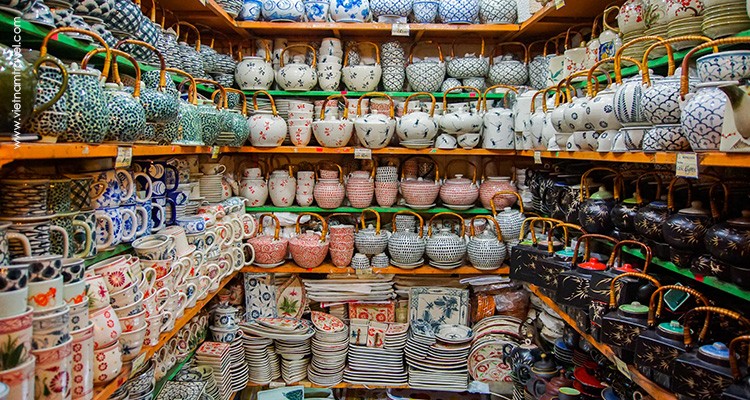 Bat Trang Pottery Village Hanoi
Bat Trang Pottery Village Hanoi
6.2. Thanh Ha Pottery Village (Hoi An)
Thanh Ha, near Hoi An, is famous for its terracotta pottery, which is lighter than other styles. The village has a long history of producing functional and decorative items for both local and international markets.
History and Tradition:
Thanh Ha was established in the 15th century. The village has maintained its traditional techniques, producing terracotta pottery with unique designs. According to a study by the Hoi An Center for Cultural Heritage Management and Preservation, in 2015, Thanh Ha’s pottery reflects the cultural fusion of the region.
Products:
Thanh Ha specializes in terracotta pottery, including tiles, bricks, and decorative items. Products are known for their durability and lightweight nature. Thanh Ha is Pottery with 20%.
Visiting Thanh Ha:
- Location: Quang Nam Province, near Hoi An
- Activities: Visit workshops, participate in pottery classes, explore the village
- Getting There: Easily accessible from Hoi An by bicycle or taxi. SIXT.VN provides reliable transportation services.
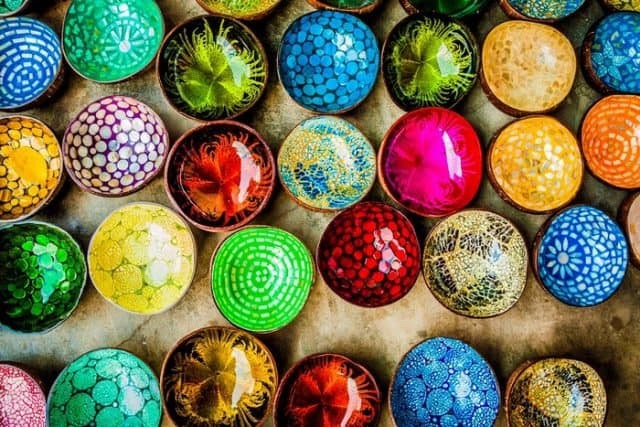 Thanh Ha Pottery Village Hoi An
Thanh Ha Pottery Village Hoi An
6.3. Phu Lang Pottery Village (Bac Ninh)
Phu Lang is renowned for its unique dark brown pottery, created using traditional wood-firing techniques. The village produces a variety of household and decorative items, known for their rustic charm.
History and Tradition:
Phu Lang has a history dating back to the 13th century. The village has preserved its traditional wood-firing techniques, producing pottery with distinctive characteristics. According to research from the Institute of Cultural Studies, in 2012, Phu Lang’s pottery reflects the cultural identity of the Red River Delta.
Products:
Phu Lang specializes in dark brown pottery, including jars, pots, and decorative items. Products are known for their durability and rustic appearance. Phu Lang is pottery with 10%.
Visiting Phu Lang:
- Location: Bac Ninh Province, near Hanoi
- Activities: Explore workshops, learn about wood-firing techniques, shop for pottery
- Getting There: Accessible from Hanoi by bus or private car. SIXT.VN offers convenient car rental services.
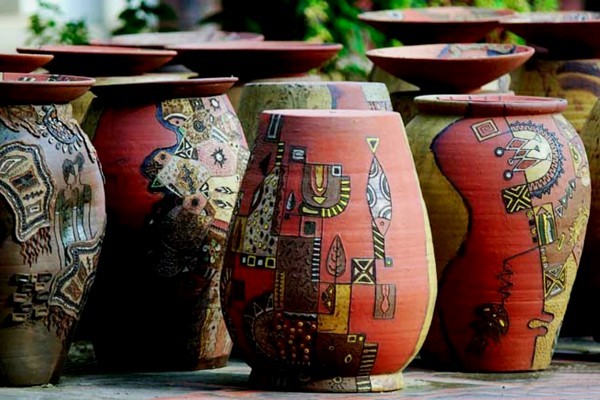 Phu Lang Pottery Village Bac Ninh
Phu Lang Pottery Village Bac Ninh
6.4. Chu Dau Pottery Village (Hai Duong)
Chu Dau pottery has more than 400 years of history. The highlights of its products are often found in the enamel colors and sophisticated motifs.
History and Tradition:
Chu Dau Pottery has more than 400 years of history. The highlights of its products are often found in the enamel colors and sophisticated motifs. Chu Dau pottery was believed to be lost forever due to historic conflicts in the past. However, efforts were made to gradually revive this pottery art and re-introduce it to both domestic and international markets.
Products:
Fine art ceramics and adding colorful, decorative products to the production is what helps the brand’s revival.
Visiting Chu Dau:
- Location: Hai Duong province
- Activities: exploring the pottery-making process and purchasing unique souvenirs
- Getting There: Private car
 Chu Dau Pottery Village Hai Duong
Chu Dau Pottery Village Hai Duong
6.5. Tho Ha Pottery Village (Bac Ninh)
The products of Tho Ha village have similar characteristics as those from Phu Lang. But what’s distinctive about Tho Ha pottery’s art lies in the glaze-free technique.
History and Tradition:
Products are shaped and fired at a high temperature to release the clay’s natural glaze. This “melted” layer acts as a glaze, and thus makes the products mold-free, sturdy with a long-lasting dark brown color.
Products:
household items made from red clay and shaped on the turntable.
Visiting Tho Ha:
- Location: Bac Ninh
- Activities: production is focused on construction, interior, and garden decoration products.
- Getting There: Private car
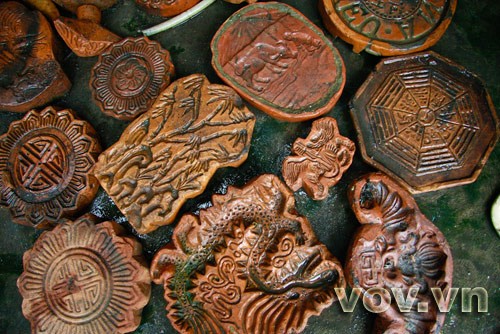 Tho Ha Pottery Village Bac Ninh
Tho Ha Pottery Village Bac Ninh
6.6. Phuoc Tich Pottery Village (Thua Thien-Hue)
Phuoc Tich pottery village once produced items for the royal family under the Nguyen Dynasty. The village craftsmen use raw dark gray clay to make household ceramics with simple patterns.
History and Tradition:
Every step of the production is done by hand with lots of love and attention.
Products:
Unglazed ceramic products like flowerpots are now even seen at respectful Japanese tea parties.
Visiting Phuoc Tich:
- Location: Thua Thien-Hue
- Activities: The village craftsmen use raw dark gray clay to make household ceramics with simple patterns
- Getting There: Private car
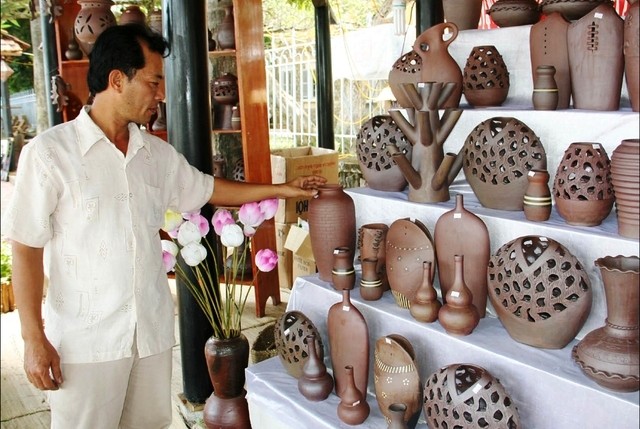 Phuoc Tich Pottery Village Thua Thien-Hue
Phuoc Tich Pottery Village Thua Thien-Hue
6.7. Bau Truc Pottery Village
Bau Truc pottery is all about Champa style. The raw material is a special clay from the banks of Quao river – flexible and durable when fired.
History and Tradition:
Traditional colors like red-gold, rose-red, brown are prominent on every product. Patterns bearing village nuances like stork wings, cauldron wings, and rivers give them a strong air of nostalgia
Products:
the meticulous craftsmanship shines through the simplicity, lightness, and rusticity in designs.
Visiting Bau Truc:
- Location: Ninh Thuan Province
- Activities: the meticulous craftsmanship shines through the simplicity, lightness, and rusticity in designs.
- Getting There: Private car
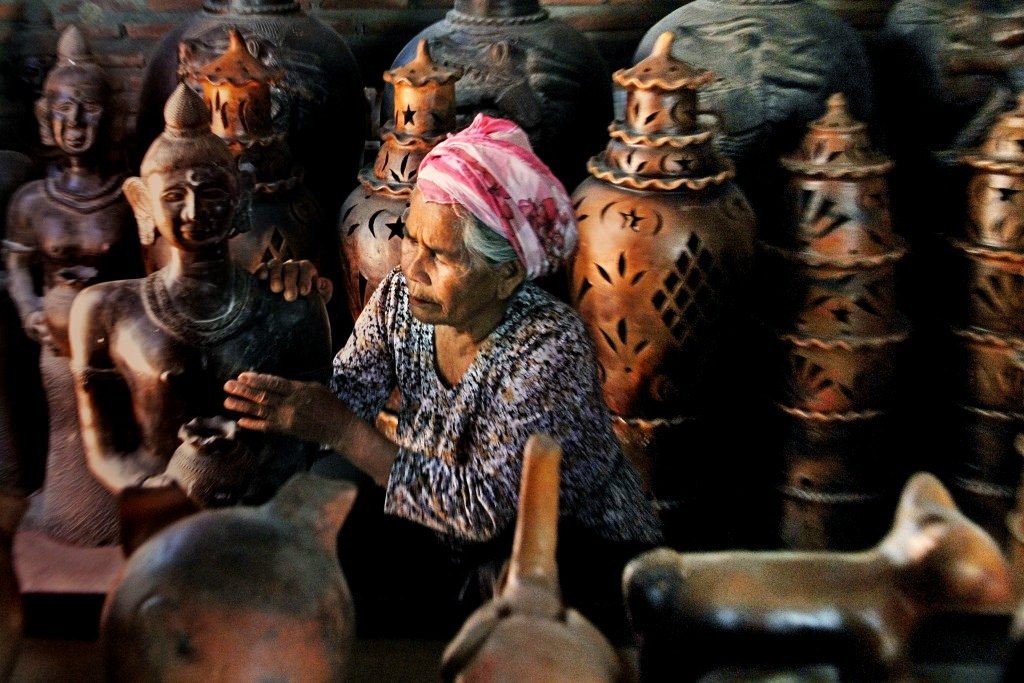 Bau Truc Pottery Village
Bau Truc Pottery Village
6.8. Bien Hoa Ceramics (Dong Nai)
What elements make up for the distinctive beauty of Bien Hoa ceramics? Simple answer: high-quality kaolin, colored clay materials, and the hands of skilled potters.
History and Tradition:
Pots, tableware, and animal statues are engraved, painted with gorgeous enamel colors.
Products:
Pots, tableware, and animal statues
Visiting Bien Hoa:
- Location: Dong Nai
- Activities: exploring more about the influential art styles on Bien Hoa products.
- Getting There: Private car
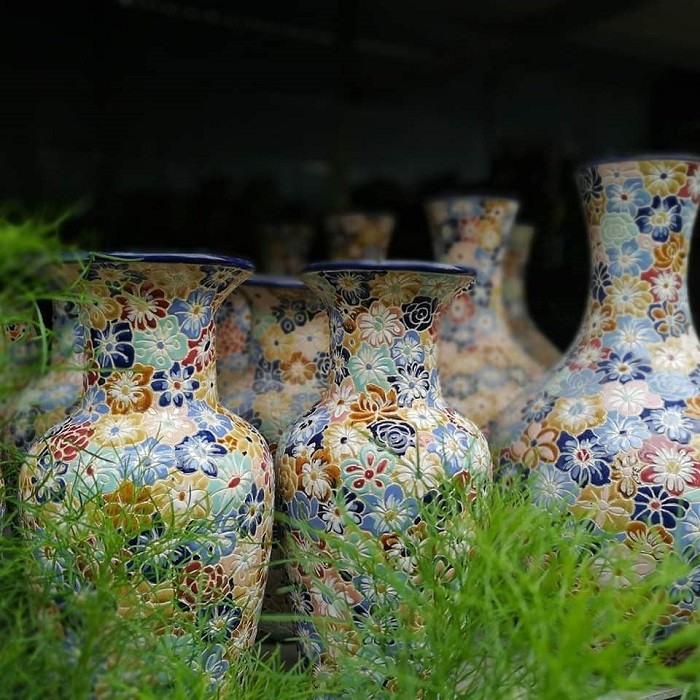 Bien Hoa Ceramics
Bien Hoa Ceramics
6.9. Lai Thieu Ceramics (Binh Duong)
Lai Thieu ceramics village was considered a latecomer. However, thanks to the abundant source of kaolin clay and fuelwood, the village still thrived.
History and Tradition:
Lai Thieu’s products used to be hand-made and fired in a traditional wood-fired kiln. Whether there were household or fine arts items, you would be guaranteed beautiful products.
Products:
household or fine arts items
Visiting Lai Thieu:
- Location: Binh Duong
- Activities: vestiges of the old Lai Thieu pottery village are almost gone.
- Getting There: Private car
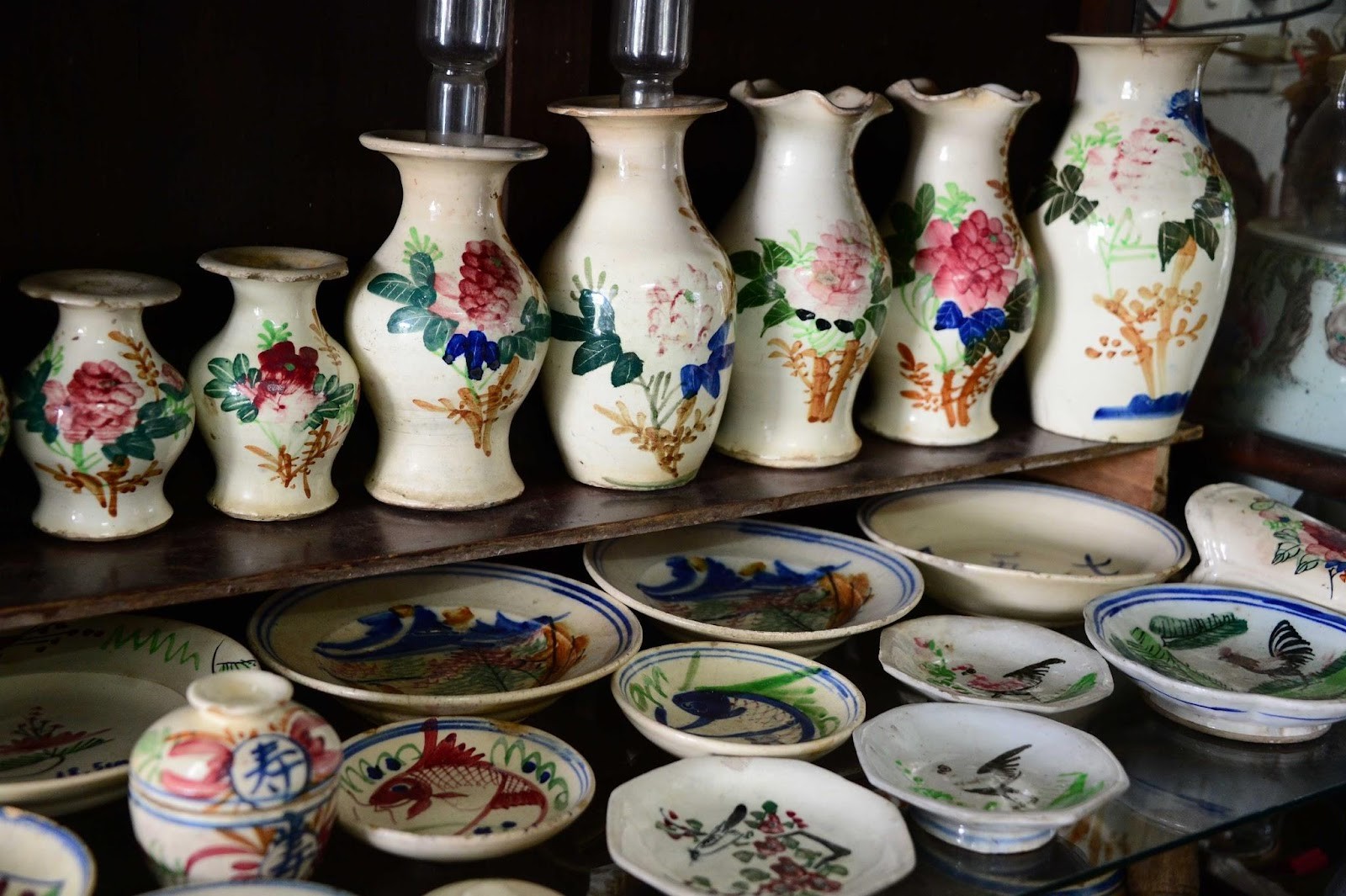 Lai Thieu Ceramics
Lai Thieu Ceramics
6.10. Vinh Long Red Clay Pottery
Vinh Long red clay pottery village sticks to its time-hallowed tradition. In the beginning, this place only specialized in making bricks, tiles, cottage bricks for temples and pagodas.
History and Tradition:
Saying “no” to luxurious, shiny enamel ceramics
Products:
construction, interior, and garden decoration products.
Visiting Vinh Long:
- Location: Vinh Long
- Activities: resembles ancient castles glowing under the golden light in a fantasy world.
- Getting There: Private car
 Vinh Long Red Clay Pottery
Vinh Long Red Clay Pottery
7. How Can You Purchase Authentic Pottery from Cay Village?
Purchasing authentic pottery directly from Cay Village ensures you receive genuine, high-quality items while supporting local artisans.
7.1. Visiting Local Workshops
The best way to purchase authentic pottery is by visiting local workshops in Cay Village. This allows you to see the pottery-making process firsthand, meet the artisans, and select unique pieces. Direct purchases also ensure that the artisans receive fair compensation for their work.
7.2. Buying from Reputable Dealers
If you cannot visit Cay Village, consider purchasing pottery from reputable dealers who source directly from the village. Ensure that the dealers are certified or recommended by local authorities to avoid counterfeit products.
7.3. Online Marketplaces
Several online marketplaces specialize in handcrafted Vietnamese products, including pottery from Cay Village. When buying online, check the seller’s reviews and product descriptions carefully to ensure authenticity. Look for platforms that support fair trade practices and direct partnerships with artisans.
8. What Are Some Tips for Caring for Vietnamese Pottery?
Proper care ensures that your Vietnamese pottery remains beautiful and durable for years.
8.1. Cleaning Techniques
Clean your pottery regularly using mild soap and water. Avoid harsh chemicals or abrasive cleaners, which can damage the glaze and surface. For stubborn stains, use a soft brush or sponge to gently scrub the affected area.
8.2. Storage Guidelines
Store pottery in a dry, cool place away from direct sunlight. Avoid stacking pottery items on top of each other, as this can cause scratches or chips. Use padding or cloth between items to prevent damage.
8.3. Handling Precautions
Handle pottery with care, avoiding sudden impacts or extreme temperature changes. When serving hot food or liquids in pottery, preheat the item gradually to prevent cracking. Avoid placing pottery directly on a hot stovetop or in a microwave unless specifically designed for such use.
9. What Cultural Experiences Can You Combine with a Visit to Cay Village?
A visit to Cay Village can be combined with other cultural experiences in the region, providing a comprehensive glimpse into Vietnamese heritage.
9.1. Exploring Local Markets
Visit local markets near Cay Village to experience the vibrant culture and sample regional cuisine. These markets offer a variety of local products, including fresh produce, handicrafts, and traditional clothing. It’s a great way to immerse yourself in the local lifestyle and support small businesses.
9.2. Attending Local Festivals
Check the local calendar for festivals and cultural events happening during your visit. These events often feature traditional music, dance, and performances, providing insights into Vietnamese customs and traditions. Participating in local festivals is a memorable way to connect with the community and experience their cultural pride.
9.3. Visiting Historical Sites
Explore nearby historical sites, such as ancient temples, pagodas, and historical landmarks. These sites offer a glimpse into Vietnam’s rich history and architectural heritage. Combining a visit to Cay Village with historical site explorations provides a deeper understanding of the region’s cultural context.
10. What Are Common Misconceptions About Vietnamese Pottery?
Several misconceptions surround Vietnamese pottery, which can lead to misunderstandings about its value and quality.
10.1. All Pottery Is the Same
One common misconception is that all Vietnamese pottery is the same. In reality, each pottery village has its unique style, techniques, and materials, resulting in diverse products. Understanding these regional differences is essential for appreciating the richness of Vietnamese pottery.
10.2. Pottery Is Only for Functional Use
Another misconception is that pottery is only for functional use. While pottery is practical, it also serves decorative and symbolic purposes. Vietnamese pottery is often considered a form of art, with intricate designs and cultural meanings.
10.3. Modern Pottery Is Inferior to Antique Pieces
Some believe that modern pottery is inferior to antique pieces. While antique pottery has historical value, modern pottery often showcases innovative designs and techniques. Modern artisans continue to evolve the craft, creating contemporary pieces that are equally valuable and beautiful.
10.4. Pottery Is Expensive
Some people assume that authentic pottery is always expensive. While high-quality pieces may have a higher price, there are also affordable options available directly from local artisans. Visiting pottery villages and buying directly from the source can provide access to reasonably priced, authentic items.
10.5. Pottery Is Fragile
Another misconception is that pottery is fragile and easily broken. While pottery should be handled with care, it is generally durable and long-lasting. Proper care and storage can ensure that your pottery remains in good condition for many years.
FAQ: Discover More About Cay Village Pottery
Q1: What is the history of pottery in Cay Village?
Cay Village has a rich history of pottery making, dating back centuries. The craft has been passed down through generations, with each family preserving unique techniques and designs.
Q2: What makes Cay Village pottery unique compared to other regions in Vietnam?
Cay Village pottery is unique due to its use of local clay, traditional firing methods, and distinctive designs that reflect the region’s cultural identity.
Q3: Can I visit Cay Village and purchase pottery directly from the artisans?
Yes, you can visit Cay Village and purchase pottery directly from the artisans. This provides an opportunity to see the pottery-making process and support the local community.
Q4: What types of pottery products are available in Cay Village?
Cay Village offers a variety of pottery products, including functional items like bowls, plates, and vases, as well as decorative pieces such as statues and figurines.
Q5: How can I ensure that I am buying authentic pottery from Cay Village?
To ensure authenticity, purchase pottery directly from local workshops in Cay Village or from reputable dealers who source directly from the village.
Q6: What are the best ways to care for my Vietnamese pottery to ensure its longevity?
Clean your pottery regularly with mild soap and water, store it in a dry, cool place, and handle it with care to avoid sudden impacts or extreme temperature changes.
Q7: Are there any cultural experiences I can combine with a visit to Cay Village?
Yes, you can combine your visit with exploring local markets, attending regional festivals, and visiting historical sites to gain a deeper understanding of Vietnamese culture.
Q8: What are some common motifs and designs found on Cay Village pottery?
Common motifs include nature scenes, historical figures, and geometric patterns, each reflecting the region’s cultural influences and traditions.
Q9: How do I get to Cay Village from Hanoi or other major cities?
You can reach Cay Village by bus or private car from Hanoi and other major cities. SIXT.VN offers convenient car rental services for easy transportation.
Q10: What is the significance of pottery in Vietnamese culture?
Pottery plays a significant role in Vietnamese culture, serving both functional and symbolic purposes. It reflects the country’s history, traditions, and artistic sensibilities.
SIXT.VN: Your Gateway to Exploring Vietnamese Pottery Villages
Planning a trip to explore the pottery villages of Vietnam? SIXT.VN offers a range of services to make your journey seamless and memorable. From airport transfers to car rentals and hotel bookings, we’ve got you covered.
Airport Transfers
Start your trip stress-free with SIXT.VN’s reliable airport transfer services. Our professional drivers will greet you upon arrival and transport you comfortably to your hotel or directly to your chosen pottery village.
Car Rentals
Explore Vietnam at your own pace with SIXT.VN’s diverse fleet of rental cars. Choose from compact cars for city driving or spacious SUVs for exploring the countryside. Our cars are well-maintained and come with comprehensive insurance options for your peace of mind.
Hotel Bookings
Find the perfect accommodation with SIXT.VN’s hotel booking service. We offer a wide range of hotels and guesthouses near the pottery villages, catering to different budgets and preferences.
Customized Tours
Let SIXT.VN create a customized tour that fits your interests and schedule. Our expert travel consultants can help you plan visits to multiple pottery villages, cultural sites, and local markets, ensuring a comprehensive and unforgettable experience.
Ready to explore the captivating world of Vietnamese pottery? Contact SIXT.VN today to book your transportation, accommodation, and tours. Let us take care of the details so you can focus on enjoying your adventure.
Address: 260 Cau Giay, Hanoi, Vietnam
Hotline/Whatsapp: +84 986 244 358
Website: SIXT.VN



